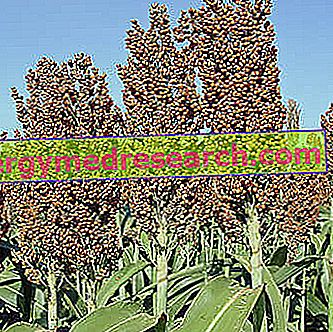Generality
Sorghum, or Sorghum vulgare Pers, is a cereal (therefore a grass) with millenary origins. Its place of origin is probably equatorial Africa, but is currently widespread in all the continents of the globe.

Sorghum is a rather important food raw material, as it ranks fourth in the world agricultural economy after wheat, rice and maize.
There are many varieties of sorghum, with traditional uses and different industrial applications
- Burr sorghum: it is used to make brooms;
- Fodder sorghum: the whole plant is used for feeding livestock;
- Sorghum from a sugary substance: where the stem of the plant is used (sorghum belongs to the same subfamily and to the same tribe as sugar cane);
- Grain sorghum: there are different varieties used, for the production of biofuels, for animal feed, for human nutrition etc.
Sorghum in Human Nutrition
The grain obtained from coarse sorghum grinding can be used for animal or human consumption, through bread-making.
The grain of sorghum for human consumption is part of the history of humanity, but in more recent times it has been supplanted by cereal crops considered more profitable.
Having remained in vogue in some poor areas of the planet (from northern Africa to India), the cultivation of sorghum has recently been revalued due to the absence of gluten, which makes it suitable for the diet of celiacs.
In the United States of America sorghum is used in fermentation for the production of beer, while in Italy its cultivation is almost irrelevant. Sorghum angolib instead, is a typically sweet sorghum variety useful for the production of molasses and sugar.
Nutritional Features, Safety and Alternative Uses
Sorghum is not distinguished by any nutritional peculiarity, so much so that its chemical composition is very similar to that of maize.
| Average nutritional composition of the Sorghum grain per 100g of edible part: | |
| Power | 327kcal |
| Protein | 11, 5g |
| Lipids | 2.3g |
| carbohydrates | 70g |
| Iron | 2, 7mg |
| Football | 25mg |
The nutritional composition of sorghum does not differ much from that of maize. | |
In some varieties of sorghum, the presence of a cyanogenetic glycoside similar to that found in bitter almonds, amygdalin, has been reported in young seedlings. Once hydrolyzed, this molecule releases hydrocyanic acid, a poison that interferes with the nervous efficiency of the respiratory muscles and which at high doses can induce death. It is a plant defense against herbivores.
It should be noted that with growth the concentrations of hydrocyanic acid are significantly reduced and do not appear to be a problem for human health; more significant concentrations could however be recorded when the plant is subjected to strong environmental stresses, such as drought conditions or excess heat.
The most suitable solution to prevent excess cyanidric acid is the maceration of sorghum in water.
The whole sorghum plant can be used for infusion; the resulting drink has purgative characteristics thanks to the durrina ; the inflorescence of sorghum is potentially hemostatic, while in India it is used to administer the decoction obtained from the roots for the treatment of the irritable stomach, fever and inflammatory states.
Bibliography:
- Cereals and legumes in the diet for health. Nature & Health - A. Formenti, C. Mazzi - New Techniques - page 261: 264
- The plants that restore health - Federico Pustet - Libreria Pontificia - Rome, 1941
- Risks and virtues of food - G. Ballarini - Calderini - Bologna 1989
- The fruits of the earth - F. Bianchini, F. Corbetta, M. Pistoia - Mondadori - Milan 1973



